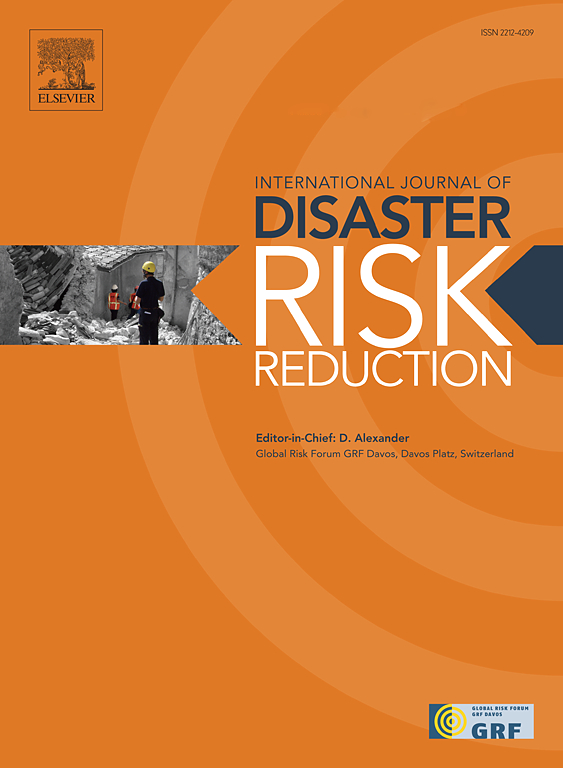Benchmarking attention mechanisms and consistency regularization semi-supervised learning for post-flood building damage assessment
IF 4.5
1区 地球科学
Q1 GEOSCIENCES, MULTIDISCIPLINARY
International journal of disaster risk reduction
Pub Date : 2025-07-23
DOI:10.1016/j.ijdrr.2025.105664
引用次数: 0
Abstract
Rapid and accurate building damage assessment (BDA) following floods is critical for effective disaster response, yet faces challenges from limited labeled data and subtle damage cues in satellite imagery. Existing deep learning change detection (CD) methods may exhibit low recall or misclassify damage inappropriately when transferred directly to the post-flood BDA (Flood-BDA) task. This study addresses these gaps by establishing the first systematic benchmark evaluating both supervised CD model transfer and semi-supervised learning (SSL) specifically for Flood-BDA. This research investigate image-level consistency regularization SSL to combat data scarcity, finding that strategies using pseudo-label derived reference distributions significantly enhance performance (+1.17% avg. Kappa at 5% labels). Notably, pseudo-label outperform ground-truth label strategies in low-label settings (e.g., +4.84% Kappa at 5% labels). Furthermore, confronting the limitations of transferred CD models (low recall, misclassifying ’destroyed’ as ’no damage’), this paper proposed a simple prior attention disaster assessment Net (SPADANet), a lightweight U-Net incorporating a simple prior attention module designed for Flood-BDA. SPADANet demonstrably improves recall (+9.22% over best CD baseline) and exhibits more favorable error patterns for Flood-BDA, despite a precision trade-off. This work provides crucial benchmarks, validates the need for recall-driven, DA-specific designs distinct from CD, and demonstrates the potential of prior attention and image-level consistency regularization for post-flood building damage assessment. The code will be available at https://github.com/JX-OctoNeko/Flood_BDA_benchmark.git

基于基准关注机制和一致性正则化半监督学习的灾后建筑损伤评估
洪水后快速准确的建筑损害评估(BDA)对于有效的灾害响应至关重要,但面临着有限的标记数据和卫星图像中微妙的损害线索的挑战。现有的深度学习变化检测(CD)方法在直接转移到洪水后的BDA (Flood-BDA)任务时可能会表现出低召回率或不恰当地对损害进行错误分类。本研究通过建立第一个系统基准来评估监督CD模型迁移和半监督学习(SSL),专门针对Flood-BDA解决了这些差距。本研究调查了图像级一致性正则化SSL以对抗数据稀缺性,发现使用伪标签派生参考分布的策略显着提高了性能(5%标签时平均Kappa +1.17%)。值得注意的是,伪标签在低标签设置下优于基本事实标签策略(例如,5%标签下+4.84% Kappa)。此外,面对迁移CD模型的局限性(召回率低,将“破坏”误分类为“无损害”),本文提出了一个简单的事前注意灾害评估网(SPADANet),这是一个轻量级的U-Net,包含一个为洪水- bda设计的简单的事前注意模块。SPADANet明显提高了召回率(比最佳CD基线提高了9.22%),并显示出更有利的洪水- bda错误模式,尽管精度有所权衡。这项工作提供了至关重要的基准,验证了与CD不同的回忆驱动、da特定设计的必要性,并展示了洪水后建筑物损害评估的预先关注和图像级一致性规范化的潜力。代码可在https://github.com/JX-OctoNeko/Flood_BDA_benchmark.git上获得
本文章由计算机程序翻译,如有差异,请以英文原文为准。
求助全文
约1分钟内获得全文
求助全文
来源期刊

International journal of disaster risk reduction
GEOSCIENCES, MULTIDISCIPLINARYMETEOROLOGY-METEOROLOGY & ATMOSPHERIC SCIENCES
CiteScore
8.70
自引率
18.00%
发文量
688
审稿时长
79 days
期刊介绍:
The International Journal of Disaster Risk Reduction (IJDRR) is the journal for researchers, policymakers and practitioners across diverse disciplines: earth sciences and their implications; environmental sciences; engineering; urban studies; geography; and the social sciences. IJDRR publishes fundamental and applied research, critical reviews, policy papers and case studies with a particular focus on multi-disciplinary research that aims to reduce the impact of natural, technological, social and intentional disasters. IJDRR stimulates exchange of ideas and knowledge transfer on disaster research, mitigation, adaptation, prevention and risk reduction at all geographical scales: local, national and international.
Key topics:-
-multifaceted disaster and cascading disasters
-the development of disaster risk reduction strategies and techniques
-discussion and development of effective warning and educational systems for risk management at all levels
-disasters associated with climate change
-vulnerability analysis and vulnerability trends
-emerging risks
-resilience against disasters.
The journal particularly encourages papers that approach risk from a multi-disciplinary perspective.
 求助内容:
求助内容: 应助结果提醒方式:
应助结果提醒方式:


